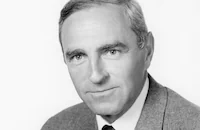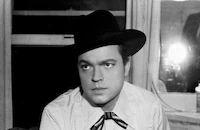Crack in the Mirror
Brief Synopsis
Cast & Crew
Richard Fleischer
Orson Welles
Juliette Gréco
Bradford Dillman
Alexander Knox
Catherine Lacey
Film Details
Technical Specs

Synopsis
In a sordid Paris tenement, Hagolin, a boorish, tyrannical laborer, berates Eponine, his young mistress, accusing her of cheating on him with the virile Robert Larnier. Meanwhile, in a wealthy Paris mansion, celebrated attorney Lamorciere hosts a party attended by his assistants, Kerstner, promising attorney Claude Lancaster and Florence, his mistress of ten years. As the older Lamorciere showers Florence with lavish gifts, Claude grumbles that his hard work laid the groundwork for Lamorciere's success. After the elder Lamorciere unexpectedly collapses, the doctor orders him to bed. Once the guests have gone home, Claude, Florence's clandestine lover, returns and jealousy ridicules her for cuckolding Lamorciere. In the tenement, Hagolin sleeps while Eponine uses her sexual wiles to entice Robert into killing him. When Robert refuses, Eponine declares that she will kill the old man herself, picks up a steel rod and smashes it on Hagolin's bed. She misses her target, however, and upon awakening, Hagolin starts to beat her. Rushing to Eponine's defense, Robert instructs Eponine to fetch his scarf, and soon after, Hagolin is dead. In the morning, Robert accuses Eponine of strangling Hagolin and asserts that he planned to use the scarf to silence, not kill him. To dispose of Hagolin, Eponine buys a saw, chops up the body and stuffs it in a laundry basket, which she and Robert then dump at a construction site. Her plan, fails, however, and soon after, Eponine is arrested for Hagolin's murder. Later, as Claude and Florence are about to make love at his apartment, a registered letter arrives, assigning Claude to defend the destitute Eponine. Thinking that the case will bring him the recognition denied by Lamorciere, Claude goes to interview Eponine in prison. When she accepts the blame for the murder, Claude tries to turn her against Robert and implies that he manipulated her into committing the crime. Later, Lamorciere and Florence meet Claude on the afternoon of their departure to Monte Carlo. Over lunch, Lamorciere describes the case as an example of a woman throwing over an older man for a younger lover and jokes that Florence should kill him if she ever decides to leave. While at the train station to say goodbye to Florence and Lamorciere, Claude encounters a reporter, who decides to write a story about Claude's involvement in the murder case. Before boarding the train, Florence begs Claude to ask her to cancel her trip, but, fearful that Lamorciere may usurp his case, Claude urges her to leave. Some time later, Florence phones Claude from Monte Carlo and discovers that he is totally absorbed in his newfound notoriety. After reading a newspaper account of the story, Lamorciere offers to help Claude, but when Claude rejects his overture, Lamorciere angrily decides to return to Paris and throw his support to Kerstner, the attorney assigned to defend Robert. As the participants recreate the murder at the scene of the crime, Lamorciere unexpectedly appears at the doorway and announces that he is joining Robert's defense. Upon returning to her cell, Eponine asks to see the Mother Superior. After Eponine confesses her sins, she is called into another interview with Claude, who, desperate to win the case, coaches her to testify that the murder was Robert's idea. In response, Eponine reveals that she has devised a plan for her defense. At the trial, Eponine recants her previous statement and then declares that she swore on the heads of her two young children to protect Robert. When Lamorciere tries to discredit Eponine, Claude calls the Mother Superior to the stand, who affirms that Eponine asked if it to would be a moral sin to betray the oath she made to Robert. After the nun states that she advised Eponine to tell the truth, the prosecuting attorney urges mercy and then the court recesses. In the hallway, Lamorciere, defeated, asks Claude to allow him to make the final argument and Claude magnanimously consents. Flush with victory, Claude hugs Florence on the stairway, unaware that Lamorciere is watching. Afterward, Florence informs Lamorciere that she is leaving him for Claude. As the trial reconvenes, Lamorciere takes the floor and draws a parallel between himself and Hagolin, both older men who have built their lives around women, only to be betrayed by them. Lamorciere recounts to the horrified jury Eponine's blow by blow account of Hagolin's dismemberment, then accuses her of destroying her lover so that she could have a younger man. Glaring directly at Florence, Lamorciere declares that Eponine should be made to pay for her sin. After Eponine is sentenced to life in prison, Claude, flabbergasted, accuses Lamorciere of double-crossing him, causing Lamorciere to collapse. Lamorciere then ironically observes that Claude may believe that he drafted all of the elder attorney's cases, but that he, Lamorciere, wrote the final speech that ruined Claude. As the prison bus drives Eponine to prison, Florence, stunned, sits with Claude on a park bench. After she asks to be alone, Claude stands up and walks into the distance.

Director

Richard Fleischer
Cast

Orson Welles
Juliette Gréco
Bradford Dillman

Alexander Knox
Catherine Lacey
William Lucas
Maurice Teynac
Austin Willis
Cec Linder
Eugene Deckers
Yves Brainville
Vivian Matalon
Jacques Marin
Martine Alexis
Marc Doelnitz
Crew
Georges Bouban
Mark Canfield
Jacques Carrère
Jean D'eaubonne
Roger Dwyre
Paul Feyder
Givenchy
Maurice Jarre
Simone Knapp
Lucie Lichtig
William Mellor
Henri Patterson
Darryl F. Zanuck

Film Details
Technical Specs

Quotes
Trivia
Notes
The onscreen credits open with an image of each of the three principal actors as reflected in a mirror. Each actor first appears as his lower-class persona, then the image in the mirror changes to reveal the actor in his upper-class persona. Studio publicity contained in the film's production file at the AMPAS Library noted that location shooting was done at the Palace of Justice, the Gare de Lyons and along the Seine River in Paris. Mark Canfield was a screenwriting pseudonym frequently used by producer Darryl F. Zanuck. A February 1960 New York Times article stated that Zanuck felt he deserved sole credit because he contributed more to the screenplay than Richard Fleischer, Julien Derode and John Shepridge, the two other writers who worked on the script. Bradford Dillman, Orson Welles, cinematographer William Mellor and director Fleischer previously worked together on the 1959 Darryl F. Zanuck Productions courtroom drama Compulsion .

Miscellaneous Notes
Released in United States Spring May 1960
CinemaScope
Released in United States Spring May 1960











